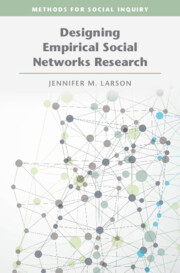Book contents
- Frontmatter
- Contents
- Figures
- Tables
- Acknowledgements
- Note on the Text
- 1 Introduction to Social Networks Research
- 2 Describing and Interpreting Social Network Features
- 3 Accounting for Substantive Network Features
- 4 Crafting a Network Theory
- 5 Moving from Theory to Empirics
- 6 Acquiring Network Data
- 7 Preparing Network Data
- 8 Working with Network Data in R
- 9 Conclusion
- Glossary
- Bibliography
- Index
8 - Working with Network Data in R
Published online by Cambridge University Press: 07 November 2024
- Frontmatter
- Contents
- Figures
- Tables
- Acknowledgements
- Note on the Text
- 1 Introduction to Social Networks Research
- 2 Describing and Interpreting Social Network Features
- 3 Accounting for Substantive Network Features
- 4 Crafting a Network Theory
- 5 Moving from Theory to Empirics
- 6 Acquiring Network Data
- 7 Preparing Network Data
- 8 Working with Network Data in R
- 9 Conclusion
- Glossary
- Bibliography
- Index
Summary
Once the data are collected and cleaned, we can start to explore features of the network. Taking an initial look at descriptive network statistics is a good way to take an overview of the data and to spot red flags that signal a problem with the data entry or cleaning. The earlier these can be identified, the better. This chapter serves as a tutorial for using R to do so using the igraph package. It introduces the process of importing a data file into R and walks through the first things you might do with the data, including computing descriptive statistics of the structural features, integrating substantive features of nodes and links, and visualizing the network.
Information
- Type
- Chapter
- Information
- Designing Empirical Social Networks Research , pp. 113 - 142Publisher: Cambridge University PressPrint publication year: 2024
